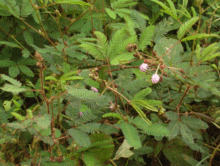Thigmonasty

In
Distinctive aspects
Thigmonasty differs from
The time scales of thigmonastic responses tend to be shorter than those of thigmotropic movements because many examples of thigmonasty depend on pre-accumulated
Botanical physiologists have discovered signalling molecules called turgorins, that help mediate the loss of turgor.[4] In species with the fastest response time, vacuoles are believed to provide temporary, high speed storage for calcium ions.[4]
Examples of plants exhibiting thigmonasty
In the Asteraceae
Thigmonasty other than leaf closure occurs in various species of thistles. When an insect lands on a flower, the anthers shrink and rebound, loading the insect with pollen. The effect results from turgor changes in specialized, highly elastic cell walls of the anthers. Similar pollination strategy occurs in Rudbeckia hirta.[5]
In the Droseraceae
The
The sundews (genus Drosera) are all capable of moving their glandular tentacles toward the center of a leaf in response to a prey item landing on it. The speed of the movement varies by species.[7]
In the Fabaceae

Mimosa pudica is a plant with
The pulvinus is a motor structure consisting of a rod of
Many other Fabaceae react to touch with the same rapid leaf closure motion. The
In the Loasaceae
Members of the subfamily
In the Oxalidaceae
Sensitive leaves also occur in plants of the
Other forms
Some
See also
References
- ISBN 978-81-7141-247-1.
- ISBN 978-1-60595-043-3.
- ISBN 978-0-674-05943-6.
- ^ ISBN 978-3-540-58016-4.
- ^ Knowlton Foote (March 2002). "Black-eyed Susan (Rudbeckia hirta L.)" (PDF). NYFA Newsletter. 13 (1). New York Flora Association: 4. Archived from the original (PDF) on December 17, 2008.
- ^ Williams, SE (2002). "Comparative physiology of the Droseraceae sensu stricto—How do tentacles bend and traps close?" (PDF). Proceedings of the 4th International Carnivorous Plant Society Conference. Tokyo. pp. 77–81.
- ^ Hartmeyer, I.; Hartmeyer, S. (2005). "Drosera glanduligera: Der Sonnentau mit 'Schnapp-Tentakeln'" [Drosera glanduligera: The Sundew with 'Snapping Tentacles']. Das Taublatt (in German) (2): 34–38.
- PMID 23603953.
- PMID 130926.
External links
- Two videos showing severe thigmonasty in mimosa plants
- Pulvinus-actuated leaf movements
- Plants In Motion
- Thigmonastic Movement
- Jaffe, M. J.; Leopold, A. C.; Staples, R. C. (2002). "Thigmo responses in plants and fungi". American Journal of Botany. 89 (3): 375–82. PMID 21665632.
